
Maurice Swansborough from Enfield
in Middlesex would, as a teenager, visit his grandfather who lived in
Hamlyn Lane, during the early 1930's. He was a keen, amateur
photographer who used his time in Exeter to take photographs of the
city. When the war started, Grandfather Swansborough moved to live with
his family in Enfield, to escape the blitz, never to return to his home.
Maurice, had considered taking up photography as a career in the
1930's, and had undergone training, but he decided not to pursue it as
a career, thinking teaching would be more secure. After the war,
Maurice, who by now had a family of his own, decided to return to
Exeter, to live in his grandfather's house and attend a teaching course
at St Lukes College. Unfortunately, the house had been commandeered by
the army during the war, and then used for rehousing by the Council
after the war. His grandfathers possessions were lost from the house
during this period, resulting in the council making a less than
adequate payment in compensation. Maurice moved his family into student
accommodation in Pinhoe Road, and commenced his course. It was during
his time at St Lukes College that the rest of the photographs date from
- he captured Exeter at that point when bomb damage was still very
evident and yet rebuilding was starting to show, like the first
daffodils of spring. He also produced some paintings of Exeter, four of
which are added at the end. When Maurice finished his course, he had
intended to stay in the city, but the loss of the house forced him to
move his family away from Exeter, leaving as a memory of his time at St
Luke's, a body of photographs that show the city in recovery.
Maurice passed away in 1985, leaving his prints and negatives locked
away and forgotten. The original negatives were rediscovered by
Maurice's grandson, Adam Bigg, who is also a photographer. Some of the
images had not been seen for 40 years, and the negatives from 1933 were
still stored rolled up, making them difficult to scan. This photo essay
is the first publication ever, of these interesting and historically
important photos. Maurice Swansborough was a photographer of some
talent, and some of these images show places that were not among those
photographed by others at that time. It is hoped that other photographs
from Maurice's time in Exeter can be restored and given a public
viewing. All photos © 2007 Adam Bigg
|
 The West Front of the Cathedral The West Front of the Cathedral
1933
A view of the Cathedral showing one of the towers surrounded by
scaffolding. The church has now gone, and the whole area is grassed -
oh, and there are no cars parked up now!
|
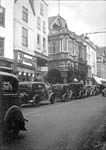 The Guildhall The Guildhall
1933 Traffic in the High Street in 1933, was worse than it is today. It
looks like a line of grid locked, black cars.
|
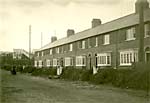 Grandfather
Swansborough's house Grandfather
Swansborough's house
circa 1933
The house in Hamlyn Lane that Grandfather Swansborough lived in. This
photographs was not taken by Maurice Swansborough.
|
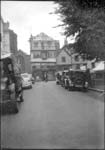 Cathedral
Close Cathedral
Close
1933
Cars have almost always had free access to Cathedral Close, parking in
any convenient place. Notice the railings around the green, which were
removed in the Second War.
|
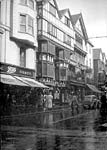 The
High Street The
High Street
1933
The High Street just by the junction with Queen Street. Boots the
Chemist was on the corner with the Express and Echo office next door.
Some of the buildings have been demolished and replaced by the C&A
building (Tesco) and others are merely facades to a modern interior.
|
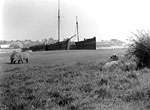 Topsham hulks Topsham hulks
1933
Old, retired boats were once dumped on the opposite side of the Exe
from Topsham, close to the canal. They were then broken up over a
period of time. The area was also used for grazing sheep.
|
 West Street West Street
1947
Two well photographed buildings in Exe Street, were the subject of
Maurice's camera in 1947. Without the car, this photo could almost have
been taken recently. The buildings were refurbished during the 1930's
and it was probably then, that the timber framing was exposed.
|
 West front, Cathedral West front, Cathedral
1947
Maurice returned to photograph the Cathedral in 1947, from a similar
viewpoint to his 1933 photo. What is interesting about this photo is
that the West Window is still boarded up to protect it from the
bombing, and also the railings around Cathedral Green have been
removed. The window had been removed in 1940 for safekeeping and it had
obviously not been put back when the photo was taken.
|
 The Cathedral The Cathedral
1949
This photograph which has Maurice Swansborough's signature added, shows
the north side of the Cathedral from what would become the centre of
Princesshay. The whole area is clear of rubble, and used as a temporary
car park. A similar view was available in 2005, after Princesshay had
been demolished.
|
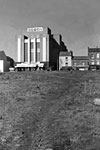 The
Odeon, Sidwell Street The
Odeon, Sidwell Street
1949 A very interesting view of the Odeon in Sidwell Street, indicates
very clearly, how the opposite side of the street was devastated and
left open, until rebuilding. Seven years after the bombing and nature
has made a start at healing the broken land. A detail view of the Odeon
reveals the film showing as the Rocking Horse Winner with John Mills.
|
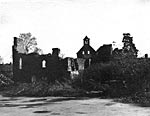 St
Catherines St
Catherines
1949
A bomb ravaged St Catherines from the rear of St Stephens Church,
before the rebuilding of the Princesshay area is started.
|
 St
Michaels, Mount Dinham St
Michaels, Mount Dinham
1949 At first glance, little has changed since this photo was taken -
however, closer inspection will show grave stones dotted around Lower
Cemetery, since removed, and a bare hillside in front of the church,
now housing that spills down the slope.
|
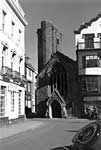 St
Martins Church St
Martins Church
1949
St Martins Church flanked by the Royal Clarence and Mol's Coffee House
in 1949, a view that is very similar today.
|
 St Lukes
College damage St Lukes
College damage
1949 This shot of St Lukes College shows the extent of the bomb damage
suffered in May 1942. Seven years later, and a start is still to be
made to repair it. Also see St Lukes
Training College.
|
 St
Lukes College damage St
Lukes College damage
1949 A general view of the college showing the missing tiles and
timbers. Enough of old buildings remained undamaged, along with some
temporary huts for students to be taught.
|
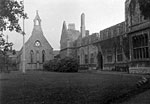 St
Lukes College Chapel St
Lukes College Chapel
1949 The bell tower of the chapel stands out against the sky, amongst
the burnt out ruins.
|
 St
Lukes College damage St
Lukes College damage
1949 The gardens are well kept, but the college still needs a lot of
work to repair it. Notice the temporary hut.
|
 Commins
Road Commins
Road
1951 Taken from 80, Pinhoe Road, this view is down Commins Road towards
Ladysmith Road.
|
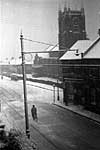 St Marks Church in the snow St Marks Church in the snow
1950 Pinhoe Road with St Marks Church, during a period of snow in
December 1950. The photograph was taken from 80, Pinhoe Road, where
Maurice Swansborough lived with his family.
|
 St Marks
Church St Marks
Church
1951 This view of Pinhoe Road is also from no 80, Pinhoe Road.
Notice that the old tram pole, acting as a lamp post, is still in
place, twenty years after they stopped running.
|
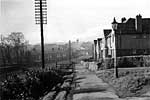 Pinhoe
Road towards Polsloe Pinhoe
Road towards Polsloe
1950 A view down Pinhoe Road towards Polsloe Bridge, from near Redlands
Close. The changes are subtle, such as the old fashioned telephone
poles and the street light. St Marks Church can be seen in the centre
distance.
|
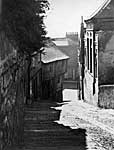 Stepcote Hill Stepcote Hill
1951 A rather attractive portrait of Stepcote Hill from 1951. The
buildings at the top of Edmund Street in the background were demolished
for Western Way in the 1960's.
|
 High
Street High
Street
1951 This block is between Castle Street and Lloyds Bank Chambers, and
shows how the High Street was rebuilt one section at a time. The cars
are parked in Bedford Street.
|
 Marks
and Spencer Marks
and Spencer
1951 Marks and Spencer built their new store on the corner of the High
Street and Castle Street. Here, Swansborough has captured the new
building while the scaffolding is still in place. The store is now the
temporary home of Next.
|
 The Express and Echo Office - High Street The Express and Echo Office - High Street
1951 The Express and Echo had their office and printing works in the
left hand of the two central buildings. The centre right building had
been J & G Ross in the first half of the 20th century.
|
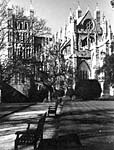 The East
Window of the Cathedral The East
Window of the Cathedral
1951 A view that cannot normally be seen now - the East end of the
Cathedral from the Bishop's Garden.
|
Maurice Swansborough also painted several pictures while he was at
St Lukes College. They are interesting because they show everyday
events and places in the city. |
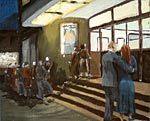 Queuing
at the Odeon Queuing
at the Odeon
1950
Instantly recognisable as the Odeon Cinema at night, Swansborough
captures that balance of the dark, with light spilling from the
foyer.
|
 An
Exeter fairground An
Exeter fairground
1950 It is not known where this fair was
held in Exeter, although it could have been Haven Banks. As the city
recovered from the war, Swansborough portrays the light relief and
excitement of the fair ground, amongst a city still covered in rubble.
|
 A bomb site blooms A bomb site blooms
1950
There were many empty bomb sites, becoming covered with vegetation in
towns all over Britain in the late 1940's and early 1950's. It is not
known where this one was, apart from somewhere in Exeter.
|
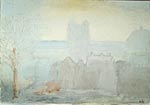 Cathedral in the mist Cathedral in the mist
1950 An evocative painting of the cathedral on a misty day.
|

